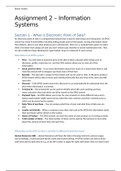Essay
Unit 3 Information Systems - Assignment 2 (P3, P4, P5, M1, M2) - Organisation Example
- Module
- Unit 3 - Information Systems
- Institution
- PEARSON (PEARSON)
Level 3 BTEC Unit 3 Information Systems | Assignment 1 - Covers how information is used within organisations, issues related to information and effects on the organisation, features and functions of Information | Extremely Detailed - 4600 Words in Total | Criteria Covered: P3, P4, P5, M1, M2 - ALL ...
[Show more]













